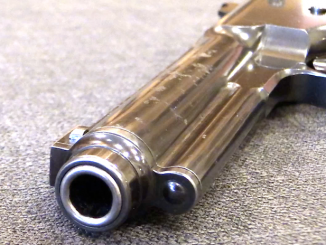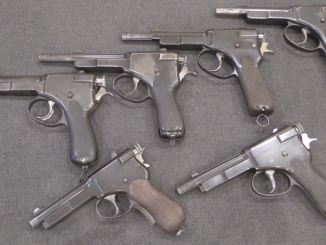The German company Erma (Erfurter Maschinenfabrik) developed a .22 rimfire kit for the Mauser 98 for the German Army in the 1920s. It was used for training, both to allow for more effective fundamental practice without the noise and recoil of full size cartridges but also to reduce ammunition cost of training and to allow the use of much smaller indoor training ranges that would not be safe to use with full-size ammunition. An Austrian military delegation saw these kits (designated the EL-24 by Erma) in use in 1925, and Austria expressed an interest in having a version made for their Steyr M95 carbines.
Testing began in 1926, and the kit was found quite acceptable. Between 1928 and 1937 a total of 905 were delivered to the Austrian Army, and were used for regular training. Austrian police forces experimented with a model for the full-length M95 rifle as well, but those were never acquired beyond testing samples.




I question the vaue of suc training aids as they don’t simulate recoil and blast, which are the major cause of flinching
I agree but given the deep economic hardship being suffered it is understandable.
For basic marksmanship training there is still value and in using the service rifle as a basis its better than simply having any assorted .22 trainer
OK, does ATF consider the adapter kit to on its own to be a firearm?
Only if it comes with it’s own receiver.
I have .22 kits for both K98’s and HK 91’s. Like them both and would love to have one for my M95. As far as training aids go, in their day they were a very efficient way to save ammo needed for the fighting, and the cost and manufacturing machinery needed to make smaller caliper training rifles. .22’s don’t have the noise or recoil of a battle rifle, but remain a good way to learn marksmanship and weapon handling skills.
The long dry spell has ended. Two real FW releases in a row. Thanks Ian!
To most all other comments (outside of the ATF question) I think Ian addressed the issue pretty well. Economics and logistics drove the wise decision to try to get more trigger time for the troops. As far as the “flinch” goes I think most would agree that it is better to work your way up to something like 8mm in a carbine than to start with a 10 gage on your first duck hunt.
Hi there!
Have you ever considered doing a review/test of the Australian smgs – OWEN SMG and the Austen.
Let alone the F1? Both of which may have been replaced by the Steyr AUG
“(…)F1(…)”
Already covered as Sterling Meets Owen: The Australian F1 Submachine Gun
https://www.forgottenweapons.com/sterling-meets-owen-the-australian-f1-submachine-gun/
“(…)Austen(…)”
Already covered as Too Late and Not Much Better: the Austen Mk II SMG
https://www.forgottenweapons.com/too-late-and-not-much-better-the-austen-mk-ii-smg/
“(…)OWEN SMG(…)”
Already covered as The Owen SMG: Looks Bad; Shoots Good
https://www.forgottenweapons.com/the-owen-smg-looks-bad-shoots-good/
Austrians, kangeroos etc. Nightmare.
Can you be more lucid in your description of shown device?
I know, Ian; what is he like.
Unclear. Under such circumstances I must assume this is hermetic joke.
Yes, there’s no recoil or blast and so little reason for flinching but I can see how sub-caliber training can help with correcting basic errors in sight picture and trigger control.
On the subject of low-cost training for recruits and conscripts/draftees not experienced with firearms, and other experienced shooters getting more trigger time with less cost and recoil, there have been many different attempts to remedy the issue in different countries and different ways. I have in my range bag subcaliber adapters to shoot .22 L R in .221 fireball in my T/C Contender (dual firing pins). I also have .30 carbine in 30-06 and .357 magnum in .350 Remington Magnum. As a method of improving my shooting with specific rifles these are very difficult to improve on, unless you are a handloader and can safely work up reduced loads for your specific rifle/caliber.
“(…)low-cost training(…)”
RAF used so-called Swift training rifle https://www.rifleman.org.uk/The_Swift_training_rifle.html for cartridge-less training. Question: how does it compare cost and effect-wise compared to sub-caliber kit?
Sub caliber inserts give options for available lower power ammo for some applications such as reduced recoil/cost of ammo, reduced length of range for safe shooting conditions and the ability to develop trigger control without flinching. Also useful in the field for hunting small game with less meat destroyed.
In .30 caliber there are adapters available for .32 ACP, .32 H&R and .30 carbine.
Other calibers that do not have specific pistol rounds in the same bore diameter, or service pistols can have specialized adapter kits to shoot .22 l r in them- Colt 1911/1911A1, Walther P38/P1 and other aftermarket kits to fit specific models of sidearms.
These are not likely to give the finest accuracy and will not be practical beyond around 75 yards.
Smart idea.
It is said that Lenin said : a lye repeated 100 tilmes is a lye, when repeated a million times it becomes truth. This is valid for the tale of the 8X56R being a machine gun round. It kicks like a full power infantry round kicks in a short light carbine. That was true for the “mousqueton Lebel (Berthier)” and was already for the mousqueton Gras.
But the scwarzlose machine gune had an influence on the 8X56
The austro hungarian were late in having a pointed bullet, they just had a lon, roundnosed bullet held by a few millimeters in a stupid tiny neck. They could have chosen a flat base pointed ,better under 600 meters but not beyond for the machine guns.
They choosed a HPBT bullet, which to enter the case a lot to be held in the neck. This reduced case capacity and thus ballistics. So that a monger case with a longer neck if possible was needed.
Additionally the 8X50 with FMJBT was clogging in the feed system of the Schwarzlose MG which requested absolutly a roud with the same COL as the 8X50. Put side by side a 8X50 and a 8X56 they have the same COL within ordinary tolerances. SO came in vue the Schwarzlose MG but that’sall, just for COL, not for power and range Like dit the swedes and italians withe their special MG 8mm.
THE 8X56 IS AN INFANTRY ROUND, NOT A SPECIAL MG ROUND !!!!!!!!!!!!!!!!!!!!!!!!!!!
The story is page 292 of the first tome of Herr MOETZ book on austrian ammo but very briefly, I have entended the story to be clearer. Hope herr MOETZ will be recognized as a competent authority. No discussion
Just have a look an ammo data 8X50 and 8X56 , they both have bullets of similar weight with similar speed, so, similar energy.
Testing started in 1926, and the kit was determined to be extremely satisfactory. Between 1928 and 1937, a total of 905 were given to the Austrian Army for regular training purposes.
it’s good